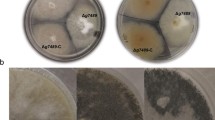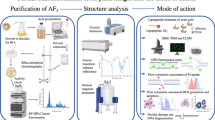Abstract
Radiolabeled amino acids (l-U[C14]alanine,d-U[C14]alanine,l-U[C14]threonine, andl-U[C14]phenylalanine) were exponentially incorporated into the trichloroacetic acid (TCA)-insoluble material (whole cells) ofMycobacterium avium during the first 30–60 min of labeling. Bacteria labeled for 48 h were extracted with chloroform-methanol (2∶1 vol/vol). The thin layer chromatography (TLC) analysis of native lipids showed that mycoside C was labeled by the amino acids used.d-cycloserine (d-CS) and other amino acid analogs were examined as potential inhibitors of mycoside C biosynthesis. It was found thatd-CS caused about 27% inhibition, whereaso-,p-, andm-fluoro-dl-phenylalanine (Fl-phe) caused 80%–90% inhibition of the mycoside C biosynthesis. Judging from the data on inhibition experiments, it was concluded that the mycoside C biosynthesis started from the fatty acyl end and proceeded by the stepwise addition ofd-phenylalanine,d-allo-threonine, andd-alanine. Thed-alanyl-d-alanine peptidoglycan intermediate did not seem to serve as a donor ofd-alanine for mycoside C biosynthesis. Ultrastructural observation of the bacteria treated withd-CS showed only partial alteration of the outer wall layer, whereasm-Fl-phe treatment caused profound alterations. Successive transfers of the bacteria in growth medium supplemented withm-Fl-phe resulted in extensive disorganization of the outer layer.
Similar content being viewed by others
Literature Cited
Barrow WW, Ullom BP, Brennan PJ (1980) Peptidoglycolipid nature of the superficial cell wall sheath of smooth-colony-forming mycobacteria. J Bacteriol 144:814–822
Brennan PJ, Souhrada M, Ullom BP, McClatchy JK, Goren M (1978) Identification of atypical mycobacteria by thin-layer chromatography of their surface antigens J Clin Microbiol 8:374–379
David HL (1970) Susceptibility ofMycobacterium intracellulare to O-carbamyl-d-serine. Am Rev Respir Dis 102:105–106
David HL (1981) Basis for lack of drug susceptibility of atypical mycobacteria. Rev Infect Dis 3:878–884
David HL, Rastogi N (1985) Antibacterial action of colistin (polymyxin E) againstMycobacterium aurum. Antimicrob Agents Chemother 27:701–707
David HL, Takayama K, Goldman DS (1969) Susceptibility of mycobacteriald-alanyl-d-alanine synthetase to D-cycloserine. Am Rev Respir Dis 100:579–581
David HL, Goldman DS, Takayama K (1970) Inhibition of the synthesis of Wax D peptidoglycolipid ofMycobacterium tuberculosis byd-cycloserine. Infect Immun 1:74–77
David HL, Rastogi N, Clavel-Sérès S, Clément F, Thorel MF (1987) Structure of the cell envelope ofMycobacterium avium. Zbl Bakt Hyg A 264:49–66
Goren M (1979) Mycobacterial lipids: chemistry and biological activities. In: Youmans GP (ed) Tuberculosis. Philadelphia: WB Saunders Co, pp 63–193
Hobby GL, Redmond WB, Runyon EH, Schaefer WB, Wayne LG, Wichelhausen RH (1967) A study on pulmonary disease associated with mycobacteria other thanMycobacterium tuberculosis. A report of the Veterans Administration Armed Forces Cooperative Study. Am Rev Respir Dis 95:954–971
Lanéelle G, Asselineau J (1968) Structure d'un glycoside de peptidolipide isolé d'une mycobactérie. Eur J Biochem 5:487–491
Minnikin DE (1982) Lipids: complex lipids, their chemistry, biosynthesis and roles. In: Ratledge C, Stanford J (eds) The biology of mycobacteria. London: Academic Press, pp 95–184
Petit JF, Adam A, Wietzerbin-Falszpan J (1970) Isolation of UDP-N-glycolyl-muramyl (ALA, GLU, DAP) fromMycobacterium phlei. FEBS Lett 6:55
Rastogi N, Fréhel C, Ryter A, Ohayon H, Lesourd M, David HL (1981) Multiple drug-resistance inMycobacterium avium: is the cell wall architecture responsible for the exclusion of antimicrobial agents? Antimicrob Agents Chemother 20:666–677
Rastogi N, Fréhel C, David HL (1986) Triple-layered structure of the mycobacterial cell wall: evidence for the existence of a polysaccharide-rich outer layer in 18 mycobacterial species. Curr Microbiol 13:237–242
Takayama K, David HL, Wang L, Goldman DS (1970) Isolation and characterization of uridine-diphosphate-N-glycolylmuramyl-L-alanyl-γ-d-glutamyl-meso-α,α′-diaminopimelic acid fromMycobacterium tuberculosis. Biochem Biophys Res Commun 39:7–12
Wolinsky E (1979) Nontuberculous mycobacteria and associated diseases. Am Rev Respir Dis 119:107–159
Woodley C, David HL (1976) Effect of temperature on the rate of the transparent to opaque colony type transition inMycobacterium avium. Antimicrob Agents Chemother 9:113–119
Author information
Authors and Affiliations
Rights and permissions
About this article
Cite this article
David, H.L., Rastogi, N., Clavel-Sérès, S. et al. Alterations in the outer wall architecture caused by the inhibition of mycoside C biosynthesis inMycobacterium avium . Current Microbiology 17, 61–68 (1988). https://doi.org/10.1007/BF01568787
Issue Date:
DOI: https://doi.org/10.1007/BF01568787




